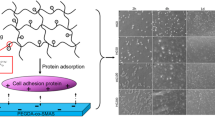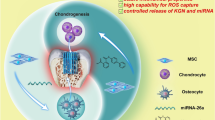Abstract
Simvastatin (SIM), a drug commonly administered for the treatment of hypercholesterolemia, has been recently reported to induce bone regeneration/formation. In this study, we investigated the properties of hydrogel composed of gelatin–poly(ethylene glycol)–tyramine (GPT) as an efficient SIM delivery vehicle that can trigger osteogenic differentiation. Sustained delivery of SIM was achieved through its encapsulation in an injectable, biodegradable GPT-hydrogel. Cross-linking of the gelatin-based GPT-hydrogel was induced by the reaction of horse radish peroxidase and H2O2. GPT-hydrogels of three different matrix stiffness, 1,800 (GPT-hydrogel1), 5,800 (GPT-hydrogel2), and 8,400 Pa (GPT-hydrogel3) were used. The gelation/degradation time and SIM release profiles of hydrogels loaded with two different concentrations of SIM, 1 and 3 mg/ml, were also evaluated. Maximum swelling times of GPT-hydrogel1, GPT-hydrogel2, and GPT-hydrogel3 were observed to be 6, 12, and 20 days, respectively. All GPT-hydrogels showed complete degradation within 55 days. The in vitro SIM release profiles, investigated in PBS buffer (pH 7.4) at 37°C, exhibited typical biphasic release patterns with the initial burst being more rapid with GPT-hydrogel1 compared with GPT-hydrogel3. Substantial increase in matrix metalloproteinase-13, osteocalcin expression levels, and mineralization were seen in osteogenic differentiation system using MC3T3-E1 cells cultured with GPT-hydrogels loaded with SIM in a dose-dependent manner. This study demonstrated that controlled release of SIM from a biodegradable, injectable GPT-hydrogel had a promising role for long-term treatment of chronic degenerative diseases such as disc degenerative disease.





Similar content being viewed by others
Abbreviations
- SIM:
-
Simvastatin
- HRP:
-
Horse radish peroxidase
- GPT:
-
Gelatin–poly(ethylene glycol)–tyramine
- MMP-13:
-
Matrix metalloproteinase-13
- OC:
-
Osteocalcin
References
Hicks GE, Morone N, Weiner DK. Degenerative lumbar disc and facet disease in older adults: prevalence and clinical correlates. Spine (Phila Pa 1976). 2009;34(12):1301–6. doi:10.1097/BRS.0b013e3181a18263.
Hassett G, Hart DJ, Manek NJ, Doyle DV, Spector TD. Risk factors for progression of lumbar spine disc degeneration: the Chingford study. Arthritis Rheum. 2003;48(11):3112–7. doi:10.1002/art.11321.
Zhang H, Lin CY. Simvastatin stimulates chondrogenic phenotype of intervertebral disc cells partially through BMP-2 pathway. Spine (Philadelphia, Pa 1976). 2008;33(16):E525–31. doi:10.1097/BRS.0b013e31817c561b.
Istvan ES, Deisenhofer J. Structural mechanism for statin inhibition of HMG-CoA reductase. Science. 2001;292(5519):1160–4. doi:10.1126/science.1059344.
Montagnani A, Gonnelli S, Cepollaro C, Pacini S, Campagna MS, Franci MB, et al. Effect of simvastatin treatment on bone mineral density and bone turnover in hypercholesterolemic postmenopausal women: a 1-year longitudinal study. Bone. 2003;32(4):427–33.
Mundy G, Garrett R, Harris S, Chan J, Chen D, Rossini G, et al. Stimulation of bone formation in vitro and in rodents by statins. Science. 1999;286(5446):1946–9.
Hatano H, Maruo A, Bolander ME, Sarkar G. Statin stimulates bone morphogenetic protein-2, aggrecan, and type 2 collagen gene expression and proteoglycan synthesis in rat chondrocytes. J Orthop Sci. 2003;8(6):842–8. doi:10.1007/s00776-003-0724-9.
Maeda T, Matsunuma A, Kawane T, Horiuchi N. Simvastatin promotes osteoblast differentiation and mineralization in MC3T3-E1 cells. Biochem Biophys Res Commun. 2001;280(3):874–7. doi:10.1006/bbrc.2000.4232.
Song C, Guo Z, Ma Q, Chen Z, Liu Z, Jia H, et al. Simvastatin induces osteoblastic differentiation and inhibits adipocytic differentiation in mouse bone marrow stromal cells. Biochem Biophys Res Commun. 2003;308(3):458–62.
Garbern JC, Hoffman AS, Stayton PS. Injectable pH- and temperature-responsive poly(N-isopropylacrylamide-co-propylacrylic acid) copolymers for delivery of angiogenic growth factors. Biomacromolecules. 2010;11(7):1833–9. doi:10.1021/bm100318z.
Bae MS, Yang DH, Lee JB, Heo DN, Kwon YD, Youn IC, et al. Photo-cured hyaluronic acid-based hydrogels containing simvastatin as a bone tissue regeneration scaffold. Biomaterials. 2011;32(32):8161–71. doi:10.1016/j.biomaterials.2011.07.045.
Zhang XZ, Jo Lewis P, Chu CC. Fabrication and characterization of a smart drug delivery system: microsphere in hydrogel. Biomaterials. 2005;26(16):3299–309. doi:10.1016/j.biomaterials.2004.08.024.
Kikuchi A, Okano T. Pulsatile drug release control using hydrogels. Adv Drug Deliv Rev. 2002;54(1):53–77.
Kimura M, Fukumoto K, Watanabe J, Ishihara K. Hydrogen-bonding-driven spontaneous gelation of water-soluble phospholipid polymers in aqueous medium. J Biomater Sci Polym Ed. 2004;15(5):631–44.
Qiu Y, Park K. Environment-sensitive hydrogels for drug delivery. Adv Drug Deliv Rev. 2001;53(3):321–39.
Jeong B, Bae YH, Lee DS, Kim SW. Biodegradable block copolymers as injectable drug-delivery systems. Nature. 1997;388(6645):860–2. doi:10.1038/42218.
Elisseeff J, McIntosh W, Anseth K, Riley S, Ragan P, Langer R. Photoencapsulation of chondrocytes in poly(ethylene oxide)-based semi-interpenetrating networks. J Biomed Mater Res. 2000;51(2):164–71. doi:10.1002/(SICI)1097-4636(200008)51:2<164::AID-JBM4>3.0.CO;2-W.
Hiemstra C, Zhong Z, Li L, Dijkstra PJ, Feijen J. In-situ formation of biodegradable hydrogels by stereocomplexation of PEG-(PLLA)8 and PEG-(PDLA)8 star block copolymers. Biomacromolecules. 2006;7(10):2790–5. doi:10.1021/bm060630e.
Jung JP, Gasiorowski JZ, Collier JH. Fibrillar peptide gels in biotechnology and biomedicine. Biopolymers. 2010;94(1):49–59. doi:10.1002/bip.21326.
Park KM, Lee SY, Joung YK, Na JS, Lee MC, Park KD. Thermosensitive chitosan-pluronic hydrogel as an injectable cell delivery carrier for cartilage regeneration. Acta Biomater. 2009;5(6):1956–65. doi:10.1016/j.actbio.2009.01.040.
Van Tomme SR, Storm G, Hennink WE. In situ gelling hydrogels for pharmaceutical and biomedical applications. Int J Pharm. 2008;355(1–2):1–18. doi:10.1016/j.ijpharm.2008.01.057.
Hatefi A, Amsden B. Biodegradable injectable in situ forming drug delivery systems. J Control Release. 2002;80(1–3):9–28.
Langer R. New methods of drug delivery. Science. 1990;249(4976):1527–33.
Kurisawa M, Chung JE, Yang YY, Gao SJ, Uyama H. Injectable biodegradable hydrogels composed of hyaluronic acid-tyramine conjugates for drug delivery and tissue engineering. Chem Commun (Camb). 2005;(34):4312–4. doi: 10.1039/b506989k.
Zheng Shu X, Liu Y, Palumbo FS, Luo Y, Prestwich GD. In situ crosslinkable hyaluronan hydrogels for tissue engineering. Biomaterials. 2004;25(7–8):1339–48.
Park KM, Shin YM, Joung YK, Shin H, Park KD. In situ forming hydrogels based on tyramine conjugated 4-Arm-PPO-PEO via enzymatic oxidative reaction. Biomacromolecules. 2010;11(3):706–12. doi:10.1021/bm9012875.
Sakai S, Hirose K, Taguchi K, Ogushi Y, Kawakami K. An injectable, in situ enzymatically gellable, gelatin derivative for drug delivery and tissue engineering. Biomaterials. 2009;30(20):3371–7. doi:10.1016/j.biomaterials.2009.03.030.
Zhang H, Wang L, Park JB, Park P, Yang VC, Hollister SJ, et al. Intradiscal injection of simvastatin retards progression of intervertebral disc degeneration induced by stab injury. Arthritis Res Ther. 2009;11(6):R172. doi:10.1186/ar2861.
Baker HJ, Lindsay JR, Weisbroth SH. The laboratory rat, volume I: biology and diseases. New York: Academic; 1979. p. 115.
Park KM, Lee Y, Son JY, Oh DH, Lee JS, Park KD. Synthesis and characterizations of in situ cross-linkable gelatin and 4-arm-PPO-PEO hybrid hydrogels via enzymatic reaction for tissue regenerative medicine. Biomacromolecules. 2012;13(3):604–11. doi:10.1021/bm201712z.
Park JB, Zhang H, Lin CY, Chung CP, Byun Y, Park YS, et al. Simvastatin maintains osteoblastic viability while promoting differentiation by partially regulating the expressions of estrogen receptors α. J Surg Res. 2012;174(2):278–83.
Khatiwala CB, Peyton SR, Metzke M, Putnam AJ. The regulation of osteogenesis by ECM rigidity in MC3T3-E1 cells requires MAPK activation. J Cell Physiol. 2007;211(3):661–72.
Gregory CA, Gunn WG, Peister A, Prockop DJ. An Alizarin red-based assay of mineralization by adherent cells in culture: comparison with cetylpyridinium chloride extraction. Anal Biochem. 2004;329(1):77–84. doi:10.1016/j.ab.2004.02.002.
Stein D, Lee Y, Schmid MJ, Killpack B, Genrich MA, Narayana N, et al. Local simvastatin effects on mandibular bone growth and inflammation. J Periodontol. 2005;76(11):1861–70.
Thylin MR, McConnell JC, Schmid MJ, Reckling RR, Ojha J, Bhattacharyya I, et al. Effects of simvastatin gels on murine calvarial bone. J Periodontol. 2002;73(10):1141–8.
Gutowska A, Jeong B, Jasionowski M. Injectable gels for tissue engineering. Anat Rec. 2001;263(4):342–9. doi:10.1002/ar.1115.
Yu L, Ding J. Injectable hydrogels as unique biomedical materials. Chem Soc Rev. 2008;37(8):1473–81. doi:10.1039/b713009k.
Wright BL, Lai JT, Sinclair AJ. Cerebrospinal fluid and lumbar puncture: a practical review. J Neurol. 2012;259(8):1530–45. doi:10.1007/s00415-012-6413-x.
Clarke C, Howard R, Rossor M, Shorvon S. Neurology: a queen aquare textbook. 1st ed. Chichester: Wiley; 2009.
Cartmell S. Controlled release scaffolds for bone tissue engineering. J Pharm Sci. 2009;98(2):430–41. doi:10.1002/jps.21431.
Zhang Y, An HS, Tannoury C, Thonar EJ, Freedman MK, Anderson DG. Biological treatment for degenerative disc disease: implications for the field of physical medicine and rehabilitation. Am J Phys Med Rehabil. 2008;87(9):694–702. doi:10.1097/PHM.0b013e31817c1945.
Adah F, Benghuzzi H, Tucci M, Russell G, England B. Cholesterol production inhibitor (statin) increased bone healing in surgically created femoral defect in an animal model. Biomed Sci Instrum. 2007;43:95–103.
Benoit DS, Nuttelman CR, Collins SD, Anseth KS. Synthesis and characterization of a fluvastatin-releasing hydrogel delivery system to modulate hMSC differentiation and function for bone regeneration. Biomaterials. 2006;27(36):6102–10. doi:10.1016/j.biomaterials.2006.06.031.
Lee Y, Schmid MJ, Marx DB, Beatty MW, Cullen DM, Collins ME, et al. The effect of local simvastatin delivery strategies on mandibular bone formation in vivo. Biomaterials. 2008;29(12):1940–9. doi:10.1016/j.biomaterials.2007.12.045.
Hayami T, Kapila YL, Kapila S. Divergent upstream osteogenic events contribute to the differential modulation of MG63 cell osteoblast differentiation by MMP-1 (collagenase-1) and MMP-13 (collagenase-3). Matrix Biol. 2011;30(4):281–9. doi:10.1016/j.matbio.2011.04.003.
Nakamura H, Sato G, Hirata A, Yamamoto T. Immunolocalization of matrix metalloproteinase-13 on bone surface under osteoclasts in rat tibia. Bone. 2004;34(1):48–56.
Ortega N, Behonick D, Stickens D, Werb Z. How proteases regulate bone morphogenesis. Ann N Y Acad Sci. 2003;995:109–16.
Acknowledgments
The authors gratefully acknowledge funding support provided by the National Institutes of Health. The project described was supported by Grant Number R01 AR056649 from NIAMS/NIH. This work was also supported in part by NIH R01 Grant CA114612 and partially sponsored by Grant R31-2008-000-10103-01 from the World Class University project of the MEST and NRF of South Korea. Victor C. Yang is currently a Participating Faculty in the Department of Molecular Medicine and Biopharmaceutical Sciences, College of Medicine, and College of Pharmacy, Seoul National University, South Korea.
Author information
Authors and Affiliations
Corresponding author
Rights and permissions
About this article
Cite this article
Park, Y.S., David, A.E., Park, K.M. et al. Controlled Release of Simvastatin from In situ Forming Hydrogel Triggers Bone Formation in MC3T3-E1 Cells. AAPS J 15, 367–376 (2013). https://doi.org/10.1208/s12248-012-9442-6
Received:
Accepted:
Published:
Issue Date:
DOI: https://doi.org/10.1208/s12248-012-9442-6




